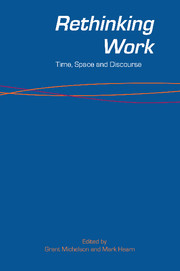Book contents
- Frontmatter
- Contents
- Tables and Figure
- Contributors
- Editorial Statement
- Abbreviations
- 1 Going to a New Place
- PART I TIME
- 2 Time and Work
- 3 The Gender Agenda
- 4 Regulation and Deregulation in Australian Labour Law
- 5 Diversity and Change in Work and Employment Relations
- 6 Transactions in Time
- PART II SPACE
- PART III DISCOURSE
- COMMENTARY
- Index
5 - Diversity and Change in Work and Employment Relations
Published online by Cambridge University Press: 05 June 2012
- Frontmatter
- Contents
- Tables and Figure
- Contributors
- Editorial Statement
- Abbreviations
- 1 Going to a New Place
- PART I TIME
- 2 Time and Work
- 3 The Gender Agenda
- 4 Regulation and Deregulation in Australian Labour Law
- 5 Diversity and Change in Work and Employment Relations
- 6 Transactions in Time
- PART II SPACE
- PART III DISCOURSE
- COMMENTARY
- Index
Summary
The changing nature of work and employment relations is often discussed in a linear fashion so that ‘old’ systems are portrayed as changing over time into ‘new’ systems. Work and employment relations in Australia have sometimes been conceptualised in terms of an ‘old’ Fordist system, based on mass production, and characterised by adversarial relations between management and unions. While accounts vary, the old system of work and employment relations was characterised as repetitious, fragmented, low-skilled, poorly paid, with low trust between managers and workers and underpinned by highly centralised wage determination processes. According to some accounts, this has been replaced by a ‘new’ system based on more flexible forms of work and employment practices which is characterised as either ‘post-Fordist’ or ‘neo-Fordist’, depending respectively on the degree of optimism or pessimism with which the commentator regards the new developments.
The focus on ‘time’ in this chapter examines a debate over the nature and regulation of work in Australia that flourished in the late 1980s and early 1990s. Some accounts of change are dichotomous and linear, and we seek to challenge the view that changes in work and employment relations have progressed from an ‘old’ to a ‘new’ model during recent decades. While there have undoubtedly been major changes over time, these have not all been unidirectional and we suggest that there has been considerable diversity in the forms of work and its regulation, the nature of the changes that have occurred, the means by which these changes have been introduced, and the probable trajectories of change for the future.
- Type
- Chapter
- Information
- Rethinking WorkTime, Space and Discourse, pp. 79 - 101Publisher: Cambridge University PressPrint publication year: 2006

